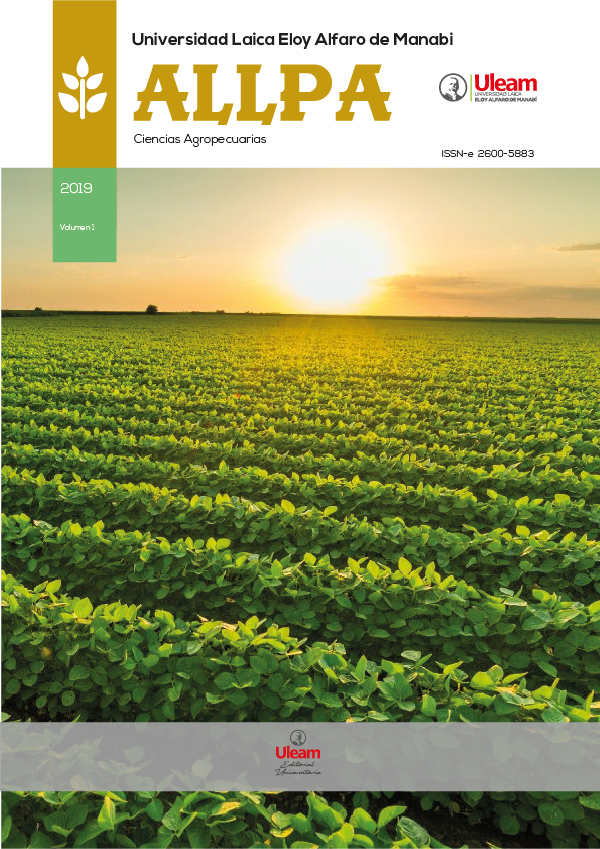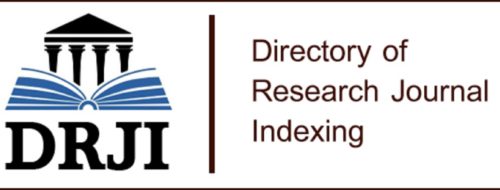Efecto de un derivado hidrocarburífero sobre el crecimiento del hongo Pleurotus ostreatus
DOI:
https://doi.org/10.56124/allpa.v7i14.0078Palabras clave:
Pleurotus ostreatus, biorremediación, tratamiento de suelos, hidrocarburos, contaminantes orgánicosResumen
Los suelos están sujetos a contaminación antropogénica derivada de la explotación petrolera, a lo largo del tiempo se han estudiado diferentes estrategias convencionales y alternativas para eliminar esta clase de contaminantes. El objetivo de este estudio fue recopilar información preliminar sobre el crecimiento del hongo ostra (Pleurotus ostreatus) en presencia de combustible con alcohol, uno de los derivados del petróleo más utilizados en el Ecuador, paralelo a esto, se evaluó la remoción de hidrocarburos totales provenientes del petróleo (HTP) en el sustrato utilizado. Para el estudio se consideró como factores de estudio el tiempo de cultivo (20 y 40 días) y la concentración del combustible (20 y 40%), además de cuantificar el número de hongos, su masa y su diámetro de sombrero, al final se obtuvo una poco significativa entre los tratamientos y una muy buena tolerancia a la presencia del contaminante que se evidencia en el crecimiento proporcional de los hongos.
Palabras clave: Pleurotus ostreatus, biorremediación, tratamiento de suelos, hidrocarburos, contaminantes orgánicos.
Fecha de recepción: 08 de abril de 2024; Fecha de aceptación: 14 de junio de 2024; Fecha de publicación: 09 de julio del 2024.
Descargas
Citas
Alegbeleye, O. O., Opeolu, B. O., & Jackson, V. A. (2017). Polycyclic Aromatic Hydrocarbons: A Critical Review of Environmental Occurrence and Bioremediation. Environmental Management, 60(4), 758–783. https://doi.org/10.1007/s00267-017-0896-2
Appels, F. V. W., Camere, S., Montalti, M., Karana, E., Jansen, K. M. B., Dijksterhuis, J., Krijgsheld, P., & Wösten, H. A. B. (2019). Fabrication factors influencing mechanical, moisture- and water-related properties of mycelium-based composites. Materials & Design, 161, 64–71. https://doi.org/10.1016/J.MATDES.2018.11.027
Arjoon, A., Olaniran, A. O., & Pillay, B. (2013). Co-contamination of water with chlorinated hydrocarbons and heavy metals: Challenges and current bioremediation strategies. International Journal of Environmental Science and Technology, 10(2), 395–412. https://doi.org/10.1007/s13762-012-0122-y
Azubuike, C. C., Chikere, C. B., & Okpokwasili, G. C. (2016). Bioremediation techniques– classification based on site of application: principles, advantages, limitations, and prospects. World Journal of Microbiology and Biotechnology 2016 32:11, 32(11), 1–18. https://doi.org/10.1007/S11274-016-2137-X
Brugnari, T., Pereira, M.G., Bubna, G.A., de Freitas, E.N., Contato, A.G., Corrêa, R.C.G., Castoldi, R., de Souza, C.G.M., Polizeli, M. de L.T. de M., Bracht, A., Peralta, R.M., 2018. A highly reusable MANAE-agarose-immobilized Pleurotus ostreatus laccase for degradation of bisphenol A. Science of The Total Environment 634, 1346–1351. https://doi.org/10.1016/j.scitotenv.2018.04.051
Bruscato, C., Malvessi, E., Brandalise, R. N., & Camassola, M. (2019). High performance of macrofungi in the production of mycelium-based biofoams using sawdust — Sustainable technology for waste reduction. Journal of Cleaner Production, 234, 225–232. https://doi.org/10.1016/J.JCLEPRO.2019.06.150
Coello Paredes, J.M., 2011. Aplicación del hongo Pleurotus ostreatus como alternativa para la biorremediación de suelos contaminados con metales pesados. Escuela Superior Politécnica del Litoral, Guayaquil. https://core.ac.uk/outputs/12410999?source=oai
Dedousi, M., Melanouri, E.-M., Diamantopoulou, P., 2023. Carposome productivity of Pleurotus ostreatus and Pleurotus eryngii growing on agro-industrial residues enriched with nitrogen, calcium salts and oils. Carbon Resources Conversion 6, 150–165. https://doi.org/10.1016/j.crcon.2023.02.001
Esa, F., Tasirin, S. M., & Rahman, N. A. (2014). Overview of Bacterial Cellulose Production and Application. Agriculture and Agricultural Science Procedia, 2, 113–119. https://doi.org/10.1016/J.AASPRO.2014.11.017
Haneef, M., Ceseracciu, L., Canale, C., Bayer, I. S., Heredia-Guerrero, J. A., & Athanassiou, A. (2017). Advanced Materials From Fungal Mycelium: Fabrication and Tuning of Physical Properties. Scientific Reports, 7(1), 1–11. https://doi.org/10.1038/srep41292
Hara, E., & Uchiyama, H. (2013). Degradation of Petroleum Pollutant Materials by Fungi. In Fungi as Bioremediators (pp. 117–133). Springer, Berlin, Heidelberg. https://doi.org/10.1007/978-3-642-33811-3_5
Huang, S., Shan, M., Chen, J., Penttinen, P., & Qin, H. (2018). Contrasting dynamics of polychlorinated biphenyl dissipation and fungal community composition in low and high organic carbon soils with biochar amendment. Environmental Science and Pollution Research, 25(33), 33432–33442. https://doi.org/10.1007/S11356-018-3271-9/TABLES/2
Islam, M. R., Tudryn, G., Bucinell, R., Schadler, L., & Picu, R. C. (2017). Morphology and mechanics of fungal mycelium. Scientific Reports, 7(1), 1–12. https://doi.org/10.1038/s41598-017-13295-2
Joshi, K., Meher, M. K., & Poluri, K. M. (2020). Fabrication and Characterization of Bioblocks from Agricultural Waste Using Fungal Mycelium for Renewable and Sustainable Applications. ASC Applied Biomaterials, 3(4), 1884–1892. https://doi.org/10.1021/ACSABM.9B01047
Kadiev, K. M., Gyul’Maliev, A. M., & Khadzhiev, S. N. (2015). Quantum-chemical modeling of strength of organometallic bonds in oil. Petroleum Chemistry, 55(8), 609–617. https://doi.org/10.1134/S0965544115080071
Kózka, B., Nałęcz-Jawecki, G., Turło, J., Giebułtowicz, J., 2020. Application of Pleurotus ostreatus to efficient removal of selected antidepressants and immunosuppressant. J Environ Manage 273, 111131. https://doi.org/10.1016/j.jenvman.2020.111131
Klimek, B., Sitarz, A., Choczyński, M., & Niklińska, M. (2016). The Effects of Heavy Metals and Total Petroleum Hydrocarbons on Soil Bacterial Activity and Functional Diversity in the Upper Silesia Industrial Region (Poland). Water, Air, and Soil Pollution, 227(8). https://doi.org/10.1007/s11270-016-2966-0
Kubartová, A., Ranger, J., Berthelin, J., & Beguiristain, T. (2009). Diversity and decomposing ability of saprophytic fungi from temperate forest litter. Microbial Ecology, 58(1), 98– 107. https://doi.org/10.1007/S00248-008-9458-8/FIGURES/5
Kumar, S., Bhushan, B., Wakchaure, G.C., Dutta, R., Jat, B.S., Meena, K.K., Rakshit, S., Pathak, H., 2023. Unveiling the impact of heat stress on seed biochemical composition of major cereal crops: Implications for crop resilience and nutritional value. Plant Stress 9, 100183. https://doi.org/10.1016/j.stress.2023.100183
Majesty, D. K. C., Winner, K., Univeristy, R., Prince, O., & Ijeoma, E. (2019). Nutritional, Anti-nutritional, and Biochemical Studies on the Oyster Mushroom, Pleurotus ostreatus. EC Nutrition, 14(1), 36–59. https://www.researchgate.net/publication/333220567_Nutritional_Anti- nutritional_and_Biochemical_Studies_on_the_Oyster_Mushroom_Pleurotus_ostreatus
Mohamad Nor, N., Lau, L. C., Lee, K. T., & Mohamed, A. R. (2013). Synthesis of activated carbon from lignocellulosic biomass and its applications in air pollution control—a review. Journal of Environmental Chemical Engineering, 1(4), 658–666. https://doi.org/10.1016/J.JECE.2013.09.017
Melanouri, E. M., Dedousi, M., Diamantopoulou, P., 2022. Cultivating Pleurotus ostreatus and Pleurotus eryngii mushroom strains on agro-industrial residues in solid-state fermentation. Part I: Screening for growth, endoglucanase, laccase and biomass production in the colonization phase. Carbon Resources Conversion 5, 61–70. https://doi.org/10.1016/j.crcon.2021.12.004
Nyinoh, I. W., & Utume, L. N. (2021). Bioremediation of spent engine oil-contaminated soil Biostimulatory effects of Pleurotus ostreatus spent substrate in bioremediation of spent engine oil-contaminated soil. IOSR Journal of Environmental Science, Toxicology and Food Technology (IOSR-JESTFT), 15(March), 9–19. https://www.researchgate.net/publication/350372782_Biostimulatory_effects_of_Pleurotu s_ostreatus_spent_substrate_in_bioremediation_of_spent_engine_oil-contaminated_soil
Pánek, M., Wiesnerová, L., Jablonský, I., Novotný, D., & Tomšovský, M. (2019). What is cultivated oyster mushroom? Phylogenetic and physiological study of Pleurotus ostreatus and related taxa. Mycological Progress, 18(9), 1173–1186. https://doi.org/10.1007/S11557-019-01515-0/FIGURES/2
Pardo Giménez, A., Perona Zamora, M.A., Pardo Núñez, J., 2008. Utilización de fibra de kenaf (Hibiscus cannabinus L.) en la elaboración de sustratos específicos para cultivo de Pleurotus ostreatus (Jacq. ex Fr.) Kummer. Rev Iberoam Micol 25, 57–61. https://doi.org/10.1016/S1130-1406(08)70015-9
Piska, K., Sułkowska-Ziaja, K., & Muszyńska, B. (2017). Edible mushroom Pleurotus ostreatus (Oyster mushroom) – Its dietary significance and biological activity. Acta Scientiarum Polonorum, Hortorum Cultus, 16(1), 151–161. https://doi.org/10.24326/asphc.2017.1.0
Sadiq, S., Mahmood-ul-Hassan, M., Ahad, K., & Nazir, S. (2019). Bioremediation of hexachlorocyclohexane (HCH) in soil using spent mushroom compost of Pleurotus ostreatus. Bioremediation Journal, 22(3–4), 126–135. https://doi.org/10.1080/10889868.2018.1516615
Setälä, H., & McLean, M. A. (2004). Decomposition rate of organic substrates in relation to the species diversity of soil saprophytic fungi. Oecologia, 139(1), 98–107. https://doi.org/10.1007/S00442-003-1478-Y/FIGURES/4
Silanikove, N., Danai, O., Levanon, D., 1988. Composted cotton straw silage as a substrate for Pleurotus sp. cultivation. Biological Wastes 25, 219–226. https://doi.org/10.1016/0269-7483(88)90081-X
Somarriba Sokolova, L. N., Ermakova, E. V., & Rynkovskaya, M. (2018). A Review of Agro- waste Materials as Partial Replacement of Fine Aggregate in Concrete. IOP Conference Series: Materials Science and Engineering, 371(1), 012012. https://doi.org/10.1088/1757- 899X/371/1/012012
Toghyani, M., Tohidi, M., Gheisari, A., Tabeidian, A., & Toghyani, M. (2012). Evaluation of oyster mushroom (Pleurotus ostreatus) as a biological growth promoter on performance, humoral immunity, and blood characteristics of broiler chicks. Journal of Poultry Science, 49(3), 183–190. https://doi.org/10.2141/jpsa.011068
Wang, S., Li, W., Liu, L., Qi, H., You, H., 2022. Biodegradation of decabromodiphenyl ethane (DBDPE) by white-rot fungus Pleurotus ostreatus: Characteristics, mechanisms, and toxicological response. J Hazard Mater 424, 127716. https://doi.org/10.1016/j.jhazmat.2021.127716
Xu, F., Chen, P., Li, H., Qiao, S., Wang, J., Wang, Y., Wang, X., Wu, B., Liu, H., Wang, C., Xu, H., 2021. Comparative transcriptome analysis reveals the differential response to cadmium stress of two Pleurotus fungi: Pleurotus cornucopiae and Pleurotus ostreatus. J Hazard Mater 416, 125814. https://doi.org/10.1016/j.jhazmat.2021.125814
Zimmermann, A., Webber, H., Zhao, G., Ewert, F., Kros, J., Wolf, J., Britz, W., de Vries, W., 2017. Climate change impacts on crop yields, land use and environment in response to crop sowing dates and thermal time requirements. Agric Syst 157, 81–92. https://doi.org/10.1016/j.agsy.2017.07.007
Publicado
Cómo citar
Número
Sección
Licencia
Derechos de autor 2024 Revista de Ciencias Agropecuarias ALLPA. ISSN: 2600-5883.

Esta obra está bajo una licencia internacional Creative Commons Atribución-NoComercial-CompartirIgual 4.0.


.jpg)










